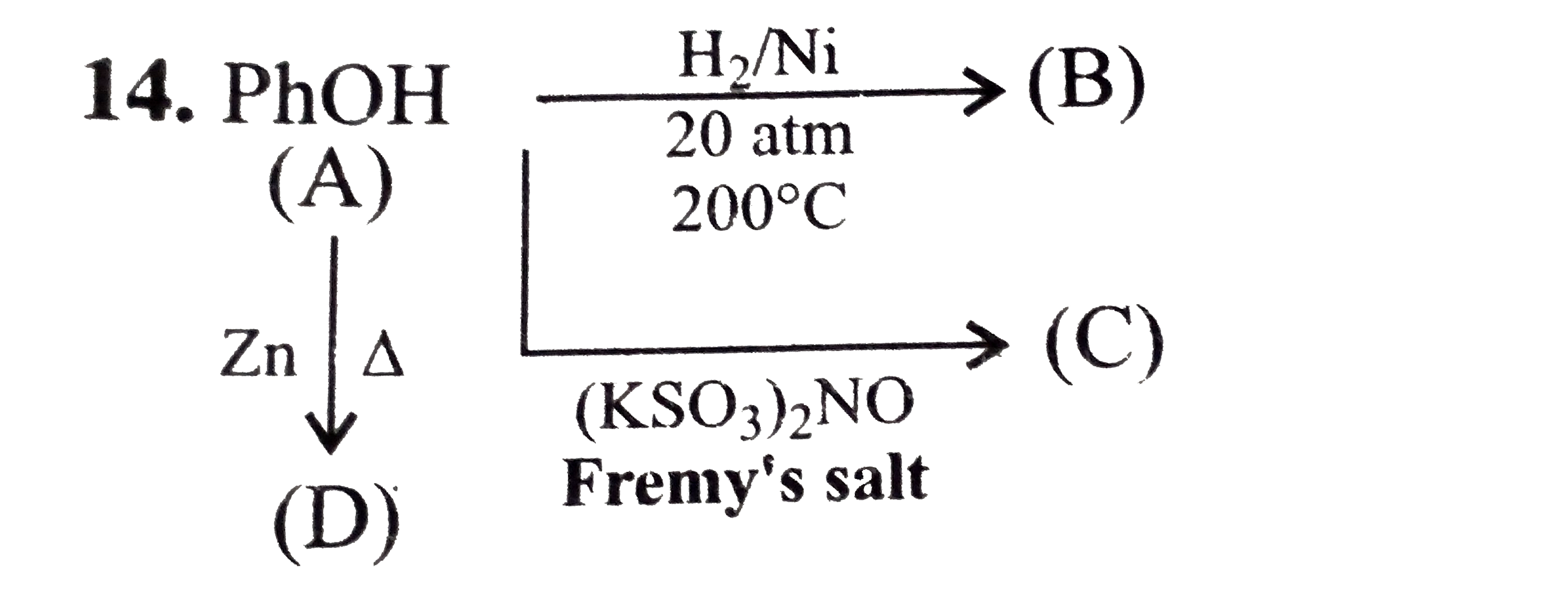Lyophilic sols are
(a)Irreversible sols
(b)Prepared from inorganic compounds
(c)Coagulated by adding electrolytes
(d)Self-stabilizing
Irreversible sols
Prepared from inorganic compounds
Coagulated by adding electrolytes
Self-stabilizing
The correct Answer is:D
To determine the correct statement about lyophilic sols, let's analyze each option step by step.
Step 1: Understand what lyophilic sols are
Lyophilic sols are colloidal systems where the dispersed phase (solid) has a strong affinity for the dispersion medium (liquid). This strong attraction results in a stable colloidal system.
Step 2: Evaluate each option
Option (a): Irreversible sols
- Lyophilic sols are not irreversible; they are reversible. When the dispersion medium is removed, they can reform when the medium is reintroduced. Therefore, this statement is false.
Option (b): Prepared from inorganic compounds
- Lyophilic sols are typically prepared from organic compounds, not inorganic ones. They are formed from substances that have a strong affinity for the solvent (liquid-loving). Thus, this statement is also false.
Option (c): Coagulated by adding electrolytes
- While it is true that electrolytes can cause coagulation, lyophilic sols require a large amount of electrolytes to achieve this due to the strong attraction between the dispersed phase and the medium. A small amount of electrolyte will not cause coagulation. Therefore, this statement is false.
Option (d): Self-stabilizing
- Lyophilic sols are indeed self-stabilizing due to the strong interactions between the dispersed phase and the dispersion medium. This stability means they do not easily coagulate and maintain their colloidal form. Thus, this statement is true.
Conclusion
The correct answer is (d) Self-stabilizing.
Lyophilic sols are colloidal systems where the dispersed phase (solid) has a strong affinity for the dispersion medium (liquid). This strong attraction results in a stable colloidal system.
- Lyophilic sols are not irreversible; they are reversible. When the dispersion medium is removed, they can reform when the medium is reintroduced. Therefore, this statement is false.
- Lyophilic sols are typically prepared from organic compounds, not inorganic ones. They are formed from substances that have a strong affinity for the solvent (liquid-loving). Thus, this statement is also false.
- While it is true that electrolytes can cause coagulation, lyophilic sols require a large amount of electrolytes to achieve this due to the strong attraction between the dispersed phase and the medium. A small amount of electrolyte will not cause coagulation. Therefore, this statement is false.
- Lyophilic sols are indeed self-stabilizing due to the strong interactions between the dispersed phase and the dispersion medium. This stability means they do not easily coagulate and maintain their colloidal form. Thus, this statement is true.
The correct answer is (d) Self-stabilizing.
Topper's Solved these Questions
- SURFACE CHEMISTRYBOOK - CENGAGE CHEMISTRY ENGLISHCHAPTER - SURFACE CHEMISTRYEXERCISE - Archives Assertion-Reasoning
1 Videos
- SURFACE CHEMISTRYBOOK - CENGAGE CHEMISTRY ENGLISHCHAPTER - SURFACE CHEMISTRYEXERCISE - Archives Fill In The Blanks
1 Videos
- SURFACE CHEMISTRYBOOK - CENGAGE CHEMISTRY ENGLISHCHAPTER - SURFACE CHEMISTRYEXERCISE - Archives Multiple Correct
3 Videos
- SOLUTIONSBOOK - CENGAGE CHEMISTRY ENGLISHCHAPTER - SOLUTIONSEXERCISE - Ex 2.3 (Objective)
9 Videos
- SYNTHETIC AND NATURAL POLYMERSBOOK - CENGAGE CHEMISTRY ENGLISHCHAPTER - SYNTHETIC AND NATURAL POLYMERSEXERCISE - Exercises Assertion Reasoning
10 Videos
Similar Questions

The compounds (B), (C ), (D), respectively are:
View SolutionWhich is not the characteristic of hydrophobic sols?
a. They are highly susceptible to coagulation by addition of electrolytes.
b. They have nearly the same surface tension and viscosity as that of dispersion medium.
c. Their stability is due to both electric charge and salvation of the particles.
d. Sol particles can be seen under ultramicroscope.
View Solution
Knowledge Check
Which of the following statement are correct ?
(i) Smaller the gold number of lyophilic colloid, larger will be its protective power
(ii) Lyophilic sols , in contrast to lyophobic sols are easily coagulated on addition of small amounts of electrolytes.
(iii) Ferric chloride solution is used to stop bleeding from a fresh cut because it coagulating the blood
(iv) The flocculatin value of arsenious sulphide sol is independent of the anion of the coagulatingA(i),(ii) and (iii)B(i) , (iii) and (iv)C(ii) , (iii) and (iv)D(i),(ii) and (iv)Lyophobic sol can be protected
a) by addition of oppositely charged sol
b) by addition of an electrolyte
c) by addition of lyophilic sol.
d) by boiling:Aby addition of oppositely charged solBby addition of an electrolyteCby addition of lyophilic sol.Dby boiling:Which of the following statement is/are correct regarding stability of sol ?
Lyophilic sols are stabilised due to a layer of solvent around sol particles.
(ii) Lyophobic sols are stabilised due to presence of charge.
(iii) Addition of lyophilic brings in more stability to lyophobic
(iv) Addition of lyophobic brings in more stability to lyophobic.A(ii) onlyB(i) and (iv) onlyC(i), (ii) and (iii) onlyDAll of these.
Coacervates are
(a) Irreversible colloidal complexes
(b) Primitive cells
(c) Reversible colloidal complexes
(d) Covered by lipoprotein
View SolutionOut of Lyophilic and Lyophobic sols, which can be easily coagulated on the addition of a small amount of electrolyte ?
View SolutionWhich of the following process is not responsible for the presence of electric charge on the sol particles?
(a)Electron capture by sol particles
(b)Adsorption of ionic species from solution
(c)Formation of Helmholtz electrical double layer
(d)Absorption of ionic species from solution
View SolutionWhich of the following can protect a gold sol from coagulation by NaCl solution?
View SolutionSTATEMENT-1 : Lyophilic sols can easily be coagulated.
STATEMENT- 2 : Lyophobic sols are stabilised by addition of lyophilic solutions.
STATEMENT- 3 : The colloidal solution of ice in an organic solvent such as CHCl3 is an example of hydrophobic
sol.
View Solution
